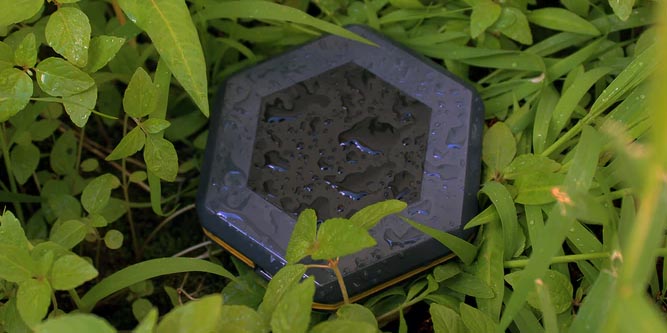We rely so heavily on communication infrastructure that a nationwide blackout would be considered a national disaster. How can you keep in touched with loved ones if the cell network was to go down? What if you were to venture out into the woods, where no coverage is available?
Now that their successful Kickstarter campaign has helped get this technology off the ground, the Sonnet wants to solve this problem. By combining common technology with some not-so-common technology, it does something no singular product on the market can. Will the Sonnet be useful in the real world? We’ll attempt to answer this question in our first look at the Sonnet Off Grid Communication Device.
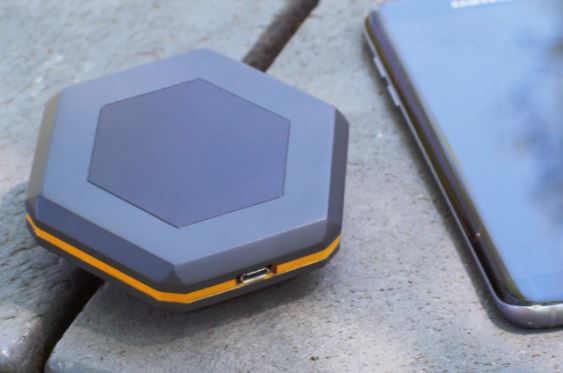
Product Overview
The Sonnet is designed to be a backup method of communication when both WiFi and the cellular network are inaccessible. It uses a special long-range wireless protocol to broadcast messages, audio recordings, images, and GPS coordinates over a range up to 15KM in distance. With the addition of mesh networking, you can transmit data over a theoretically unlimited distance, provided you place enough Sonnets in between yourself and your end point. It’s definitely unlike any product we’ve come across before. As they describe it, it’s like a walkie-talkie and a satellite phone combined. However, there are some usage considerations with the Sonnet, so it’s important that you understand exactly how it works before you commit to one.

Design & Durability
The Sonnet is a small black hexagon. It’s got a grey stripe around the outside bezel, and the edge is lined with a yellow stripe. There’s a micro-USB port in the bottom for charging, and a full size USB port on the top to charge your mobile devices.
It’s fairly compact, with roughly the same width as the diameter as a tennis ball. It sits flat in your hand, and is just small enough to slip into your back pocket. The build is extremely sturdy. This makes sense, as it’s designed to be used outdoors. Even if you were to sit on it while it’s in your back pocket, you’re unlikely to break it. Like any piece of technology, it still has its limitations. However, we consider the physical strength of the Sonnet to be more than enough for the average backpacker.
One key advantage is it’s water resistance. It’s rated for IP66, just one point shy of the highest rating possible. In terms of dust protection, this means that it can survive the dustiest environment out there – it’s fully sealed. For water, it’s resistant but not proof. You can leave it outside during a rain storm, or you can spill a drink on it. The only thing that it won’t survive is complete submersion for an extended period of time. Short of a tsunami, the Sonnet can withstand anything mother nature can throw at it.

Network Technology
The Sonnet runs on the 917 MHz frequency. This frequency is called the ISM (Industrial, Scientific, and Medical) band. Just like the 2.4 and 5 GHz channels your router runs on, the 915 MHz ISM band is available for public use with no licensing. This means that you don’t need to pay a subscription fee to use it, and you’re not relying on any 3rd party providers.
Some countries don’t allow use of the 915 MHz ISM band. In Europe, it runs on the 868 MHz frequency. In Asia, 433 MHz is used. It’s possible that there are small variances in range and speed. Europe and North America should see fairly consistent results, but Asia’s will likely be more limited in terms of bandwidth.

Realistically speaking, bandwidth isn’t much of a concern for the Sonnet. Consumer networking gear uses some very complex broadcast standards to give ultra-high speeds. The Sonnet is much simpler. It uses Chirp Spread Spectrum. It’s a little like morse code, sending binary pulses across a large part of the ISM spectrum. This means that it’s going to be a little slow, but makes massive distances possible. It broadcasts at 30 dBm – the maximum power allowed by an unlicensed user. But the receiver can work with a signal as low as -148 dBm, making the massive range possible.
What kind of range can you expect? On standard terrain, 5KM is possible. When there is line of sight, 15 Km is possible. This opens a lot of doors.
For example. Let’s say you were hiking in the woods. You leave one Sonnet in your car where it has a connection to the internet. You then scale a mountain, and attach a Sonnet to a balloon and a string to anchor it. At this point, you can then climb down the other side of the mountain. As long as you can see the Sonnet, you’ll be able to use the central one to bounce communication to any device within it’s range.
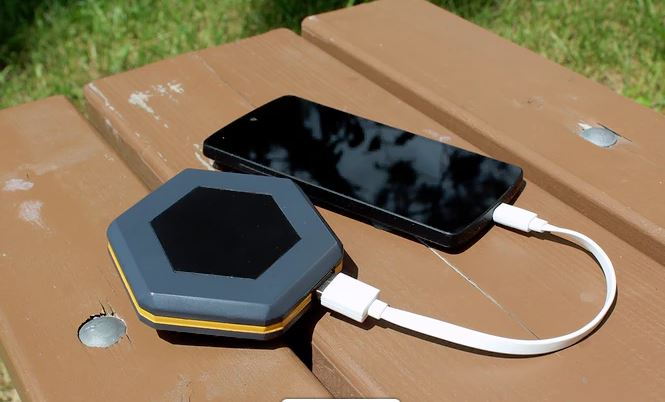
Functionality
We know what the Sonnet looks like, and we understand the advanced technology that makes it possible. How does it work in the real world? Using it is simple. You need at least two Sonnets, and you need two smartphones. As an example, let’s say that you’re going to be hiking in the woods and you want to keep in touch with your friend, who remains at your campsite. Your friend will keep one Sonnet, and connect to it using his smartphone. You carry your Sonnet and smartphone out into the woods.
To communicate, you need to visit a certain website from your browse. This website is redirected the Sonnets online interface. This works just like a messaging app. You can send messages to a specific user, a group of users, or post messages publicly to all Sonnets within range. The messages can be text, photos, voice recordings, or GPS coordinates. You can also download maps while in cell service, and access them through your sonnet.
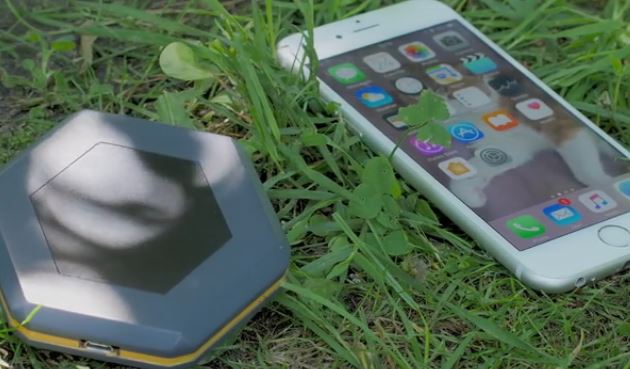
If you are going to have more than 5km of distance in between Sonnets, you’ll need to leave one in between you. The Sonnet can “hop-scotch” data from one to the other, allowing you to cover a much larger distance.
It’s important to note that all communication is restricted to the internal Sonnet app – it doesn’t replace your cell carrier. You can’t use standard texts, and you can’t access the internet yet. Eventually, the Sonnet is going to support re-broadcasting internet from one device to another. It supports IPV6, so we expect this connection to work fairly well. It will, however, be a little slow. The bandwidth will be more than adequate to check social media, get updates from your favorite news sites, or send emails. But you shouldn’t expect to be watching Netflix on it.
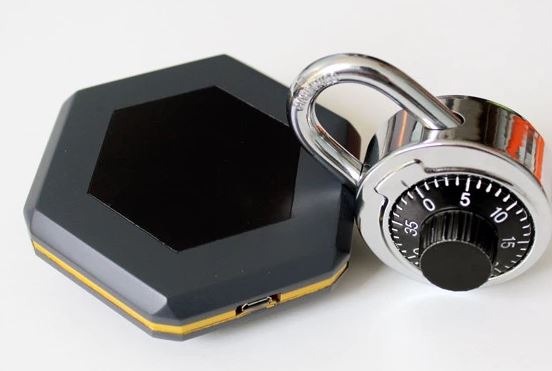
Features
Since the Sonnet is designed to be used off grid, there is a good chance that you won’t have access to all of the same comforts you’d get at home. The top USB port can be used to charge your phone when you’re running low. There are limitations to this. The Sonnet has a 4000 mAh capacity, which allows it to last 24 hours. The average phone has a 2400 mAh capacity battery. This means that if you were to take a completely dead phone and charge it all the way up, you’d reduce the battery life of the Sonnet by nearly half. That being said, it’s a great feature to have in a bind. When you do get a chance to recharge it, it only takes 2 hours to fully charge the battery.
For safety, the Sonnet has a built in SOS system. Just press a single button, and an SOS message will be broadcasted to everyone within range. The message will pop up on their phone, and include both your GPS coordinates and a short message if you choose to include one. This is handy if you’re out hiking, or any other situation where you could be at risk.
Finally, the Sonnet has advanced security features built right in. Everything is encrypted with 256-bit AES encryption. If anyone were to listen in on your private conversations, they’d never be able to deconstruct your messages.
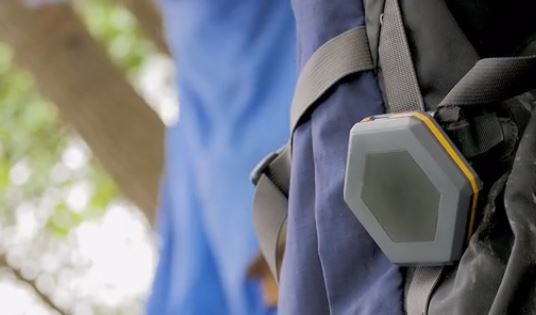
Disadvantages
The biggest disadvantage to the Sonnet is going to be adoption. If they truly want to meet their goal of developing a completely off-grid device, they’re going to have to have a lot of Sonnets out in the wild. For now, it works great as a medium range communication device. But if they want it to help protect society from a natural disaster, you’d need a huge grid of them to cover a large area.
Final Verdict
Despite being a brand new technology, the Sonnet fills a pretty big void in the market. The users who would benefit most from it are going to be outdoor enthusiasts. Whether you’re climbing, hiking, or camping, the Sonnet allows you to keep in touch with somebody to ensure your safety. It can also be used at crowded public events, where the cellular reception might not be all that great. If the technology catches on, it could also make a fantastic backup network in the event of a serious network outage. Overall, this is one promising piece of technology that has plenty of potential.
Meet Ry, “TechGuru,” a 36-year-old technology enthusiast with a deep passion for tech innovations. With extensive experience, he specializes in gaming hardware and software, and has expertise in gadgets, custom PCs, and audio.
Besides writing about tech and reviewing new products, he enjoys traveling, hiking, and photography. Committed to keeping up with the latest industry trends, he aims to guide readers in making informed tech decisions.

